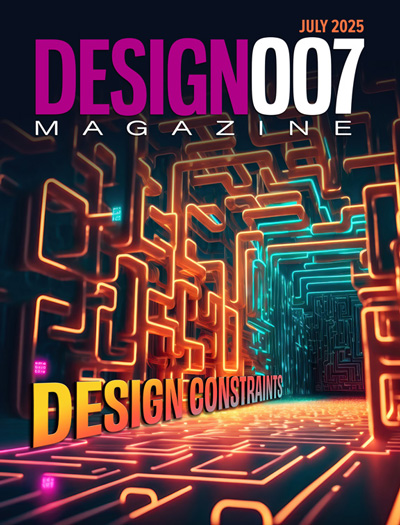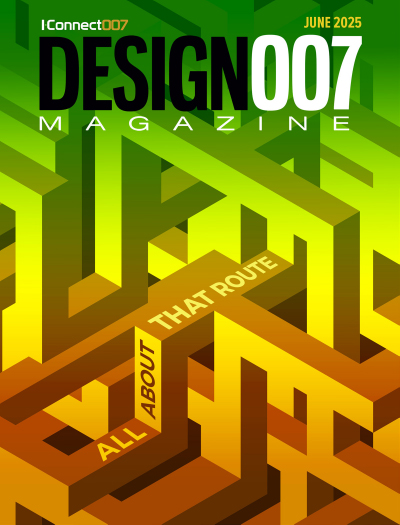-

- News
- Books
Featured Books
- design007 Magazine
Latest Issues
Current Issue
Proper Floor Planning
Floor planning decisions can make or break performance, manufacturability, and timelines. This month’s contributors weigh in with their best practices for proper floor planning and specific strategies to get it right.

Showing Some Constraint
A strong design constraint strategy carefully balances a wide range of electrical and manufacturing trade-offs. This month, we explore the key requirements, common challenges, and best practices behind building an effective constraint strategy.

All About That Route
Most designers favor manual routing, but today's interactive autorouters may be changing designers' minds by allowing users more direct control. In this issue, our expert contributors discuss a variety of manual and autorouting strategies.
- Articles
- Columns
- Links
- Media kit
||| MENU - design007 Magazine
Cadence Managed Cloud Service Drives Automotive Sensor Solutions for Murata Finland
December 14, 2023 | Cadence Design Systems, Inc.Estimated reading time: 3 minutes
Did you know that a modern automobile might contain as many as 100 sensors? Automotive sensors are electronic devices that measure pressure, acceleration, inclination, temperature, and much more, feeding this data back to the vehicle's various control units. They also come in a mind-boggling array of configurations, many of them safety-critical. Today, they are indispensable components of an intelligent automotive system.
Micro-electro-mechanical systems (MEMS) are sensors that convert pressure or physical movement into electrical signals. MEMS-interfacing ASICs control MEMS element behavior and measure the tiny signals received from the element, perform signal processing, and then generate the digital output.
Murata is the world’s leading manufacturer and supplier of inertial sensors for the automotive industry. It designs, develops, and manufactures sensors based on patented 3D MEMS technology in Finland. Considering the safety-critical nature of its products, Murata Finland requires a state-of-the-art EDA environment for their design and verification.
This is where the Cadence Managed Cloud Service comes in, an EDA-optimized platform with a fully integrated and proven cloud environment to launch product design, verification, and implementation. The platform serves a full front-to-back design flow, partial design flow, and hybrid cloud-based peak capacity to augment an on-premises compute environment.
Cadence and Murata Finland: Extending a Partnership
Recently, Murata Finland and Cadence renewed their license agreement, which enables Murata Finland to leverage Cadence’s advanced EDA software hosted securely in the cloud.
Using the Cadence Managed Cloud Service, Murata Finland was able to improve engineering productivity by 10% when developing a mixed-signal MEMS-sensing ASIC for a new product, including accelerometer and gyroscope MEMS, in collaboration with its design partners and Cadence design services. Cadence’s cloud solution ensured that critical resources within the Murata Finland ASIC team focused on design rather than IT tasks. Furthermore, third-party designers could seamlessly collaborate with Murata designers.
Murata Finland also scaled up the cloud solution quickly when it needed additional capacity or when adding engineers to the project. Cadence provided 24/7 support for the cloud environment and resolved any issues promptly. With efficient preventative maintenance, the critical phases of the project went smoothly. Additionally, Murata Finland kept the project on schedule by leveraging Cadence design services and EDA tool support.
“As a leading manufacturer of inertial sensors for the automotive industry, Murata requires a state-of-the-art EDA environment for the design and verification of our safety-critical products,” said Ville-Pekka Rytkönen, general manager, Product Development at Murata Finland. “The Cadence Managed Cloud Service allowed us to quickly scale when additional capacity was needed, or when new engineers were added to the project. Because our ASIC team could focus on critical design rather than IT tasks, collaboration with our third-party designers was seamless. The Cadence Managed Cloud Service also enabled the effective use of Cadence design services and support when needed.
“Managing downtime in IT systems is crucial in such projects”, reported Ville-Pekka Rytkönen from Murata Finland. Cadence Managed Cloud Service maintained an uptime of more than 99.9999% (above the industry standard) during the project.
“The Cadence Managed Cloud Service provides a secure, collaborative design environment that allows customers like Murata Finland to quickly and easily harness the power of the cloud without assuming a heavy IT burden,” said Mahesh Turaga, vice president of Cloud Business Development at Cadence. “Murata Finland was also able to leverage Cadence design services and EDA tool support to mitigate risk associated with IT system downtime or failure, keeping their microchip project on schedule.”
With the global automotive sensors market set to grow at 11.68% to a staggering $71 billion by 2030 and constant evolution in sensor technology itself, this is clearly a very competitive and dynamic industry. Cadence Managed Cloud Service ensures that Murata maintains its lead in the automotive sensor market by providing a secure and collaborative design environment.
Testimonial
"The I-Connect007 team is outstanding—kind, responsive, and a true marketing partner. Their design team created fresh, eye-catching ads, and their editorial support polished our content to let our brand shine. Thank you all! "
Sweeney Ng - CEE PCBSuggested Items
Elementary Mr. Watson: Routing Hunger Games—May the Traces Be Ever in Your Favor
08/26/2025 | John Watson -- Column: Elementary, Mr. WatsonI’d like to share a harsh truth, and I say this as a friend: PCB designers are often their own worst enemy. It’s rarely the complexity of the circuit, the last-minute changes from mechanical, the limited enclosure space, or the ever-expanding list of design rules that send projects to the dust heap of failed boards. More often, it's our own decisions, made too quickly and narrowly, and with too little foresight, that sabotage an otherwise good design.
I-Connect007 Editor's Choice: Five Must-Reads for the Week
08/22/2025 | Andy Shaughnessy, I-Connect007In this week’s roundup, we have a variety of articles covering design, manufacturing, sustainability, and, of course, tariff negotiations. We have a milestone anniversary to celebrate as well, with Dan Beaulieu about to publish his 1,000th column. When does Dan even sleep? Here’s to hoping that we have 1,000 more weeks of "It’s Only Common Sense."
New Episode Drop: MKS’ ESI’s Role in Optimize the Interconnect
08/26/2025 | I-Connect007In this latest episode, Casey Kruger, director of product marketing at MKS’ ESI, joins On the Line With… host Nolan Johnson to share how CO₂ laser technology delivers faster, more accurate vias in a smaller, more energy-efficient footprint.
PEDC Call for Abstracts Deadline Extended to Aug. 31
08/20/2025 | I-Connect007 Editorial TeamThe second Pan-European Electronics Design Conference (PEDC) will take place Jan. 21-22, 2026, in Prague, Czech Republic. The call for abstracts deadline has been extended to Aug. 31. Organized jointly by the German Electronics Design and Manufacturing Association (FED) and the Global Electronics Association (formerly IPC), PEDC serves as a European platform for knowledge exchange, networking, and innovation in electronics design and development.
How Good Design Enables Sustainable PCBs
08/21/2025 | Gerry Partida, Summit InterconnectSustainability has become a key focus for PCB companies seeking to reduce waste, conserve energy, and optimize resources. While many discussions on sustainability center around materials or energy-efficient processes, PCB design is an often overlooked factor that lies at the heart of manufacturing. Good design practices, especially those based on established IPC standards, play a central role in enabling sustainable PCB production. By ensuring designs are manufacturable and reliable, engineers can significantly reduce the environmental impact of their products.


